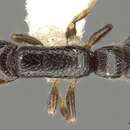pt-BR
nomes no trilho de navegação


> Simopone Forel, 1891: 139 [[ worker ]]. Type: Simopone grandidieri , monobasic.
> Cerapachys subgenus Simopone : Forel, 1892: 243; also Simopone subgenus Cerapachys , p. 247, lapsus.
> Simopone : Emery, 1911: 15 - 16, pl. 1, fig. 7, [[ worker ]]? [[ male ]], species list.
> Simopone : Arnold, 1915: 19 - 21, diagnosis, 1 S African sp. described.
> Simopone : Santschi, 1923: 259 - 263, 3 C African spp. described.
> Simopone : Taylor, 1965: 1 - 6, review of generic characters, list of spp. ----- 1966: 287 - 290, Indo-Australian spp.
Worker: Distinguished from Cerapachys in all species by the lack of apical spurs on the tibiae of middle legs. Other Simopone characters are the elongate head (2 exceptions) with widely separated frontal carinae forming partial scrobes for the antennal scapes (1 or 2 exceptions), large compound eyes placed at, or in front of, the midlength of the head (1 exception), 11 - merous antennae (1 exception with 12 segments), and toothed tarsal claws (sometimes with an extra tooth or lobe at base of claw). Ocelli frequently present or their pits indicated. The petiole is usually more or less depressed and marginate laterally.
Sculpture varying with the species from smooth and shining to finely reticulate or striolate in part, or with spaced punctures. Pilosity usually sparse, the longer hairs tending to be bilaterally positioned. Color yellow, brown, black or bicolored.
Queen: Unknown for most species; in S. bakeri a normal dealate form exists, with differences from the conspecific worker paralleling those of Cerapachys .
Male: The diagnosis given by Emery (1911: 15) applies only doubtfully to Simopone . In fact, the male caste of this genus has yet to be described from specimens certainly associated with workers or queens.
Larva: The larva of S. conciliatrix (as " Simoponen. sp. ") has only recently been described by G. C. and J. Wheeler, 1974: 103 - 104, fig. 2. It is much like the larvae of Cerapachys but has small mouthparts, including peculiar multidentate mandibles.
distribution: Simopone is widespread but sporadic in the wet, Old World tropics, from Natal in South Africa through Central and East Africa and Madagascar, and in the Indo-Australian region from southeastern Asia to New Guinea and the Philippines. The genus is uncommon in collections, probably because of its predominantly arboreal habitat, and the distribution is probably wider than known at present.
bionomics discussed under the tribal rubric above.
Simopone is a genus of predominantly arboreal ants in the subfamily Dorylinae.[2] The genus is widely distributed in the Old World tropics, with the majority of species in Madagascar and sub-Saharan Africa.[3]
The genus was first described by Forel (1891), based on a Simopone grandidier specimen.[4] Brown (1975) revised the genus and recognized 13 species altogether. The number of species was raised to 15 by Kutter (1976, 1977) and to 38 by Bolton & Fisher (2012). Bolton & Fisher considered one of the African species described by Brown (1975), S. conciliatrix, so different from all the others in the genus that it is transferred to its own monotypic genus, Vicinopone.[5]
Simopone species are almost entirely arboreal, but on occasion foraging workers are found on the ground or in rotten logs. Prey records are extremely sparse for this genus, consisting only of Crematogaster brood by S. vepres, and the brood of Terataner by S. sicaria. Nevertheless, these two records support the general supposition by Brown (1975) that most or all members of tribe Cerapachyini prey on other ants, or more probably the brood of other ants, but actual records are extremely rare.[5]
Known queens are entirely worker-like except that the mesosoma has a full complement of flight sclerites. No queen recognizable by external morphology has been seen in any Malagasy species, the queens of which are suspected to be remarkably ergatoid, or perhaps even replaced by gamergates.[6] Workers of most (perhaps all) species exhibit considerable size variation.[7]
Simopone is a genus of predominantly arboreal ants in the subfamily Dorylinae. The genus is widely distributed in the Old World tropics, with the majority of species in Madagascar and sub-Saharan Africa.
Simopone é um gênero de insetos, pertencente a família Formicidae.[1]
Simopone é um gênero de insetos, pertencente a família Formicidae.
Simopone (лат.) — род муравьёв (Formicidae) из подсемейства Cerapachyinae (Cerapachyini). Мирмекофаги. Около 40 видов.
Встречаются в тропиках Старого света (Африка, Мадагаскар, Юго-Восточная Азия). Специализированы на питании другими видами муравьёв (мирмекофагия). Мелкие узкотелые муравьи (5—7 мм). В стебельке 1 членик (петиоль), но первый сегмент брюшка резко отделён перетяжкой от остальных, напоминая формой второй членик стебелька (постпетиоль) некоторых других муравьёв (Myrmicinae). У рабочих усики 11-члениковые и имеются оцеллии. Формула щупиков: 6,4 или 5,3 (число члеников нижнечелюстных и нижнегубных щупиков). Глаза крупные (соотношение длины глаза к ширине головы, EL/HW = 0,30-0,53), скапус короткий (соотношение длины скапуса к ширине головы, SI = 33-56). Преимущественно древесные виды (изредка рабочие фуражируют на земле)[2].
Около 40 видов, половина из которых была описана в 2012 году. Род был выделен в 1891 году швейцарским биологом Огюстом Форелем[2].
Simopone (лат.) — род муравьёв (Formicidae) из подсемейства Cerapachyinae (Cerapachyini). Мирмекофаги. Около 40 видов.